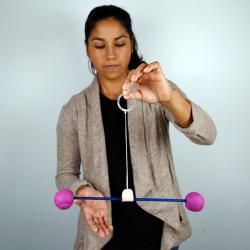Source Institutions
Source Institutions
Add to list Go to activity
Activity link broken? See if it's at the internet archive

"Exploring the Universe: Objects in Motion" encourages participants to explore the complex but predictable ways objects in the universe interact with each other. Stars, planets, moons, and other objects in space orbit around each other because of gravity, and NASA scientists can use what we already know about the laws of physics to make new discoveries and predictions. Participants in this activity use "orbiting" clay balls to make simple, functioning models of interacting objects in space.
- Under 5 minutes
- 5 to 10 minutes
- 1 cent - $1 per student
- Ages 6 - 14
- Activity, Model
- English
Quick Guide
Materials List (per student)
- 12-inch stained wooden rod
- Small leather sling with attached string (medical grade finger sling)
- Acrylic ring
- Playdough
- Sandpaper (to clean the wooden rod)
- Activity and facilitator guides Information sheets
- Tips for Leading Hands-on Activities
- Digital scale and the Exploring Ratios information sheet (optional)
Subjects
-
Earth and Space Science
-
Astronomy
- Probes, Satellites and Spacecraft
-
Solar System
- The Sun
- The Moon
- The Planets
- Asteroids and Comets
-
Astronomy
-
Physical Sciences
-
Motion and Forces
- Gravity
- Kepler's Laws
- Center of Gravity
-
Motion and Forces
Other
This resource is part of:
- Explore Science: Earth & Space toolkits
- Explore Science: Earth & Space 2018Toolkit
- NISE Network Catalog
Access Rights:
- Free access
By:
- National Informal STEM Education Network
Source Collection
- NISE Network
Rights:
- Creative Commons: Non-commercial Share Alike (by-nc-sa), National Informal STEM Education Network, 2017
Funding Source:
- NASA, NNX16AC67A
